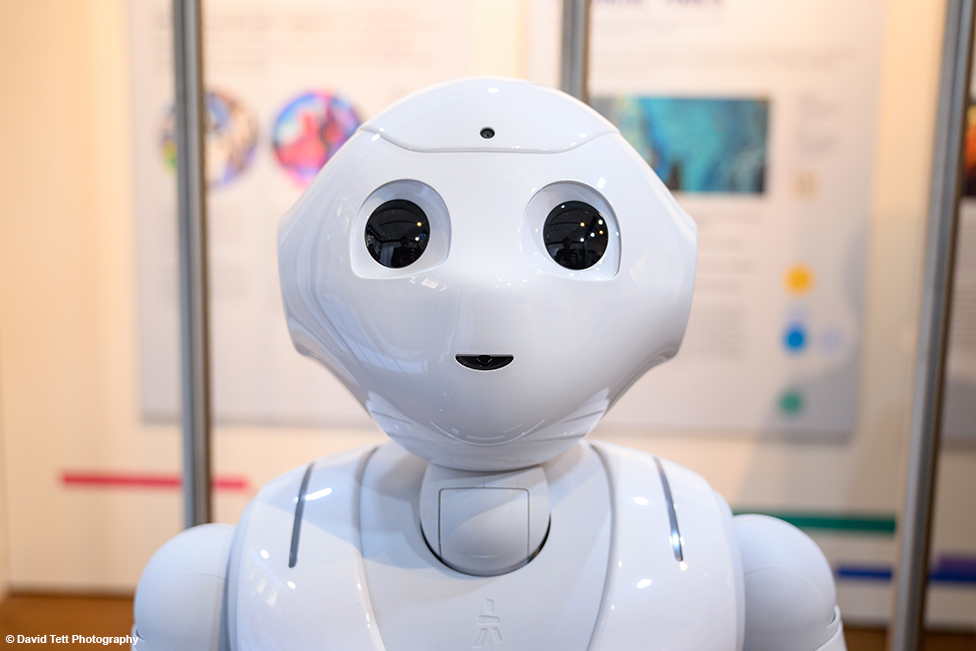
This AI educational exhibit tests the audience’s assumptions and perceptions of a technology that divides opinion.
Background
The King’s Institute for Artificial Intelligence brings together the diverse and growing community in AI at King’s College London.
The significant activity in AI across King’s reflects the achievements in the field in the last few years, as well as the wider implications brought by the increased awareness of AI in society as a whole, conversations around the impact of the technology on a wide range of industries, the importance of legislating and regulating, and emerging issues that need to be addressed. In our client’s words, a holistic perspective on AI must draw on philosophy, social science and the law, and involve experts from diverse application domains.
Challenge
To deliver an accessible and engaging AI educational exhibit that would be part of an exhibition showcasing AI work at the Bush House space at King’s Strand Campus.


The aim of the event was to communicate King’s work in AI to the wider cultural community, to bring visibility to staff, students, alumni, and the general, non-specialist, public by inviting them to explore important developments in AI technology and its applications in the real world, as well as the societal benefits and challenges that may arise.
Solution
Our rationale for the exhibit design is rooted in creating an emotional hook to immediately provoke an internal debate in every single member of the audience. Without asking a question directly, the exhibit magnifies the undeniable fact that AI technology raises many questions and opposed feelings of excitement and fear.
Despite this being an indoor experience, we maximised the outside (the recently pedestrianised Strand Aldwych) to attract people inside by positioning the exhibit against a large window (approximate dimensions 2.5m x 2.8m), with the window itself playing a major role in sparking debate and curiosity to find out more.

Behind the glass window, dressed with poignant messaging, an AI robot is clearly visible chained to a cell-like structure, starting a story that continues inside.


Once inside, the audience are treated to a stage-like experience that elicits an immediate emotional, existential response: AI robots are the heroes of the installation, the focal point of the story, whether friend or foe.

Rethink Robotics’ Baxter triggers an emotional response:
“Why is he chained and behind bars? Are we protecting humanity from the robot – or the robot from humanity?”
These are questions going through the audience’s minds.



Before arriving at the final design for the Artificial Intelligence (AI) educational exhibit, we had considered a slightly different approach, which we discussed and tested with our client – positioning Pepper, a humanoid robot also used in the exhibition, inside a cage with bent bars, which he eventually breaks free from.



In the end, we discarded the bent bars idea as we didn’t want to condition the audience’s feelings and reaction: during the testing stage, subjects felt confused, projecting human emotion onto Pepper and wondering why such a human-like, adorable [sic] robot was in a cage in the first place.


From a technical and logistics perspective, this was also an interesting project for us to be involved in. Working in collaboration with the AI and Engineering departments at King’s, we built the 3mx3mx3m cage to be a self-supporting structure that fully complied with the regulations a Listed building is bound by, where no support elements can be fixed to the floor or walls.
All the components were pre-fabricated and then transported to Bush House, where they could be assembled in situ to transform them into a lightweight structure that managed to look solid and secure, highly realistic.

Different AI robots could be wheeled in an out at different times, and the opening within the structure enticed audiences to step in, interact and experience the feeling of being ‘behind bars’.
The structure also incorporated lighting which added to its appeal as natural light faded later in the day, attracting the attention of passers-by.
Despite being faced with some timing, budget and space constraints, the exhibition was a success.



We built the structure in a way that can be easily taken down and repurposed at different locations in the future, stretching our client’s budget further.
Looking for help with your project?
Feel free to give us a call to start a conversation,
our doors are always open.
Related projects

AstraZeneca
Augmented Reality (AR) experience

Polecat
Branding development

Jacobs
Conference booth design
